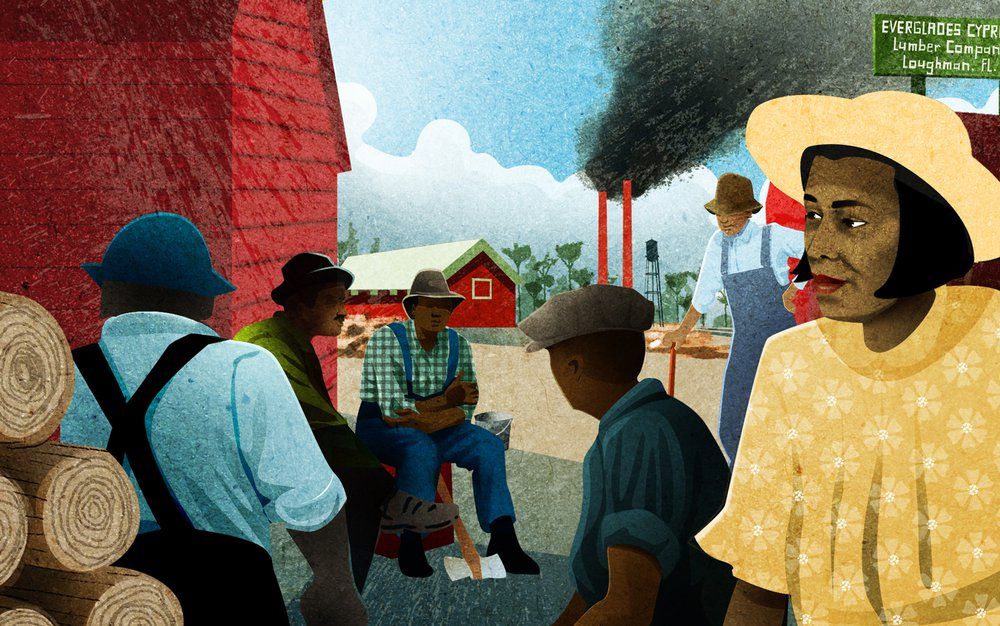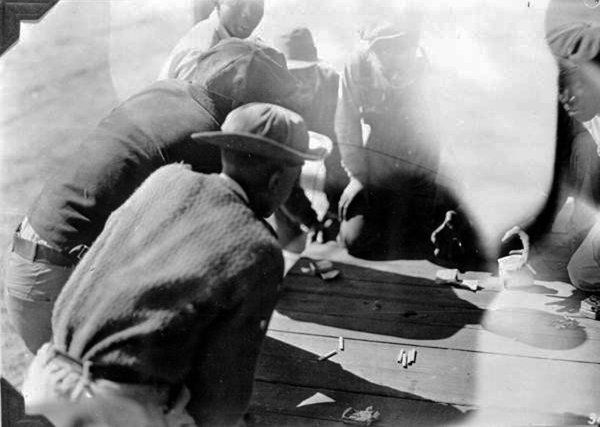This is BEN GREENBERG's portfolio site.
Contact Archives Search Feed Blog🔗 About ↑This is BEN GREENBERG's portfolio site.
Contact Archives Search Feed Blog🔗 About ↑This article was originally published by American Experience to accompany its documentary, THE SWAMP. Text by Cori Brosnahan with illustrations by Laura Freeman.

In 1928, Zora Neale Hurston traveled to Polk County, Florida to collect folklore. She ended up at a lumber camp, where African Americans from around the South worked long hours in difficult conditions. By the time she left — in a hurry, at knifepoint — she had collected a slew of stories that would become the first book of African American folklore written by an African American. For Hurston, these tales would provide endless inspiration, breathing life into her masterpiece, Their Eyes Were Watching God.
There were a lot of ways to die in the lumber camps of Polk County. On the job, there were snakes, alligators and — most dangerous of all — the trees themselves. A man might be chest-high in swamp water and trying to keep his balance on slimy ground, when a 150-foot cypress tree ignored the path loggers intended and crashed down where it pleased, creating what one researcher described as a “domino effect from hell.” Or, maybe the tree was safely felled but slipped when they tried to hoist it onto the train car. If some unlucky man happened to be in the tree’s way, the train would come back into the camp early and everyone who heard the whistle blow knew that something was wrong.
Off the job, the camp was even more deadly. White overseers didn’t hesitate to use force against the majority black workforce, nor did local police. Sometimes it was the law that put laborers in camps in the first place. Tiffany Patterson, a history professor at Vanderbilt University, writes about how debt peonage, outlawed by Congress in 1867, continued to supply a large portion of the labor force in lumber camps up until World War II. In the post-Reconstruction South, black men (and occasionally others) could be arrested and fined for spitting on the sidewalk or simply not having a job — the so-called crime of vagrancy. If a man couldn’t pay, his fine could be bought by a lumber company, where he’d labor until his debt was settled. Other camp residents were real criminals — convicted or fugitive — who carried knives and weren’t afraid to use them.
 Men load pine logs onto a flatcar in Florida ca. 1920s. State Archives of Florida
Men load pine logs onto a flatcar in Florida ca. 1920s. State Archives of Florida
“It was rough,” says Patterson. “They were brought there by violence and then violence is the everyday.”
For her book, Zora Neale Hurston and a History of Southern Life, Patterson traveled to Polk County, Florida, where Hurston conducted anthropological fieldwork in the late 1920s. A former resident of the Everglades Cypress Lumber Company took Patterson to the grounds of the sawmill camp in Loughman. The land had been returned to forest except for one patch, covered in a mound of “chalk-white earth, unlike any dirt [Patterson] had seen before.” This was where local people believed the bodies of those who tried to escape were buried.
Mules and Men, the fruit of Hurston’s folklore-gathering fieldwork, has been criticized for ignoring the brutal reality of black laborers in the South. But Patterson says that wasn’t Hurston’s objective. “She’s trying to show the lived experience. In their living, they were creating a vibrant culture and a beautiful language.”
 Turpentine workers gamble for cigarettes on payday in Florida ca. 1930s. Hurston visited turpentine camps in Cross City for the Federal Writers’ Project in 1939. State Archives of Florida
Turpentine workers gamble for cigarettes on payday in Florida ca. 1930s. Hurston visited turpentine camps in Cross City for the Federal Writers’ Project in 1939. State Archives of Florida
The language itself was of utmost importance for Hurston, who often wrote her fiction in black vernacular. In his afterword for the book, Henry Louis Gates, Jr. writes, “It is this concern for the figurative capacity of black language, for what a character in Mules and Men calls ‘a hidden meaning, jus’ like de Bible… de inside meanin’ of words’ that unites Hurston’s anthropological studies with her fiction.”
Hurston herself said she wanted to explore “that which the soul lives by.” By the time she left the Everglades Cypress Lumber Company — in a hurry, at knifepoint — she had collected a slew of stories about mules and men, men and men, and men and women. The first book of African American folklore written by an African American is a catalogue not of the ways people died but of the ways they lived.